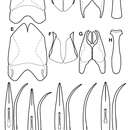Description
provided by Zookeys
Length: 1.75–2.06 mm, width: 1.50–1.65 mm; body rufescent, elongate ovoid, widest well behind humeri, moderately, evenly convex; microsculpture almost completely absent, vague rudiments present at sides of abdominal sterna; frons flat, not markedly depressed at middle, frontal stria complete; supraorbital stria absent; labrum about twice as wide as long, weakly emarginate apically, with weak apical process below margin; left mandible untoothed, right with small, subacute basal tooth; antennal club only slightly elongate; pronotal disk lacking prescutellar impression, ground punctation sparse, but conspicuous, with few coarser punctures sparsely scattered along sides; marginal stria barely descending to hypomeron at sides, only narrowly interrupted behind head; lateral submarginal pronotal stria complete, close to side, curving inward toward front, nearly meeting anterior submarginal stria, which is recurved posterad about one-third the length of the pronotal disk; median pronotal gland openings about two-thirds pronotal length from anterior margin; elytra with two complete epipleural striae, outer subhumeral stria nearly complete, but briefly interrupted at middle, inner subhumeral stria absent, striae 1-5 complete, sutural stria barely abbreviated basally; prosternal keel weakly emarginate at base, with complete carinal striae barely converging anteriorly, united in anterior arch; prosternal lobe with nearly complete marginal stria very close to margin; mesoventral margin with narrow, but distinct median projection, marginal stria complete; mesometaventral stria narrowly angulate anteriorly, reaching just forward of mesoventral midpoint; lateral metaventral stria extending to middle of metacoxa; 1st abdominal ventrite with complete inner lateral stria, outer slightly abbreviated, sides of disk with punctures coalesced into elongate strigosity; propygidium with ground punctation fine, sparse, with small round punctures evenly separated by about their diameters; pygidium with fine, sparse ground punctation and very few coarser punctures interspersed, mainly in basal corners; marginal pygidial stria fine, nearly complete, though obsolete at base and narrowly interrupted at apex. Male genitalia (Figs 57E–H) extremely similar to those of Operclipygus geometricus, differing by T8 with sides slightly narrowing; S8 shorter, sides more strongly convergent toward apex, apical guides narrower; T9 halves approximate for about middle third of their length, apices narrow, weakly convergent; S9 very narrow for most of apical half, abruptly expanded to basal half, basal margins subparallel, rounded apically; tegmen indistinguishable from that of Operclipygus geometricus (see Fig. 57J), widest in basal half, narrow in most of apical half, with very narrow ‘U’-shaped medioventral process barely projecting beneath.
- license
- cc-by-3.0
- copyright
- Michael S. Caterino, Alexey K. Tishechkin
- bibliographic citation
- Caterino M, Tishechkin A (2013) A systematic revision of Operclipygus Marseul (Coleoptera, Histeridae, Exosternini) ZooKeys 271: 1–401
- author
- Michael S. Caterino
- author
- Alexey K. Tishechkin

